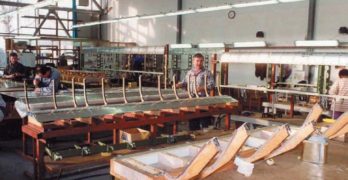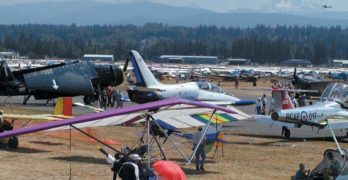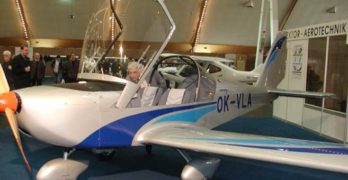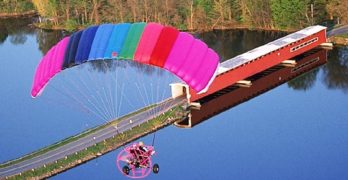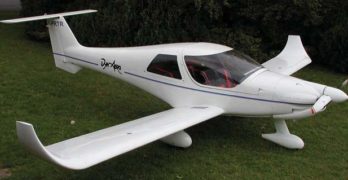An American finds success building aircraft overseas.
This is not a story about a Czech company. It’s about an American company in the Czech Republic, a distinction that makes this story different.
For months we have been hearing and reading about sport pilot and light- sport aircraft (LSA). The FAA’s new rule is creating plenty of excitement for some very good reasons. That excitement is not confined to the U.S. Overseas manufacturers are eyeing the new rule as a way to enter the U.S. market. One of those in the best position to take advantage of the new rule is Czech Aircraft Works (CZAW).
An American In Prague
Chip Erwin hails from Wisconsin. Today, he is an American who owns a company in the Czech Republic. His CZAW has become one of that country’s largest aircraft producers. He accomplished all of this during the single decade when the Czech Republic regained its independence.
Search Results for : Flight Design
Not finding exactly what you expected? Try our advanced search option.
Select a manufacturer to go straight to all our content about that manufacturer.
Select an aircraft model to go straight to all our content about that model.
Airborne Australia
A light-sport contender?
As the FAA’s proposed SportPlanes™/light-sport aircraft (LSA) rule moves steadily closer to becoming a law of the land, intense focus has been concentrated on candidate aircraft from overseas.
Though many pilots excited by the new rule are paying attention to fixed-wing designs, these are hardly the only aircraft that will qualify under the proposed regulation. In fact, consensus standards being devised by the industry to certify LSA have separate committees writing recommendations for powered parachutes and trikes (weight-shift). (Committees for gyroplanes, gliders, airships and balloons are also possible, but are not presently active.)
This month, “Light Stuff” looks at AirBorne Australia. Though its home is an immense distance from our shores and despite many other trike entries from the U.S. and overseas, AirBorne has built a solid following among Americans. However, AirBorne is one of those companies that does more than initially meets the eye.
Going Both Ways
Besides the Australian company, I can think of only two other manufacturers that currently build both ultralights and hang gliders.
Silent Trikes
Meet the Silent family of sleek trikes
Most trikes (powered hang gliders) use fiberglass only for nose pods and wheelpants. The Silent brand of trikes from Germany is an exception as these machines use composite materials for much of the trike carriage or chassis. The Silent family includes four models, two of which are still in production.
Although the Silent trikes are well known to Germans and other Europeans, it took Australian light aviation pioneer Bill Moyes to introduce the stunning Silent Racer to American skies. I first came across this unusual machine at Florida’s Wallaby Ranch before the Sun ’n Fun airshow three years ago.
But I’ve had other contact with developer Helmut Grossklaus as he has, not once, but twice been saved by the same BRS parachute installed in his aircraft. I collected info about this in my role at BRS. Neither accident was the fault of the equipment but of flying circumstances.
Six Chuter Spirit
Veteran company Six Chuter has led the powered parachute pack since 1991.
With more than 1000 powered parachutes in the air, Six Chuter, Inc. of Yakima, Washington, is one of the leading companies in an increasingly crowded field. However, things haven’t always gone so well for the company. In 1992, Six Chuter nearly went out of business. Down to less than $1000, the company closed a three-unit sale that saved it.
The order signaled the beginning of the powered parachute phenomenon, and Six Chuter has never looked back. Sales hit 112 units in 1994, and they have grown ever since. Six Chuter has seen the industry develop dramatically, and it’s been a major player every step of the way.
When Six Chuter employees attended what they feared might be their last airshow a decade ago, prospects looked bleak. Company owner Dan Bailey recalls: “We were less than well received at the show.
New Aircraft Arrive at Arlington
With 200-foot-tall trees and mountain peaks topped with snow throughout the year, Washington is a scenic place for an airshow. Despite a drought that caused the grass to crunch underfoot, light aviation looked alive and well at the EAA’s Arlington gathering for 2003.
Local Boys Make Good
One main attraction was the much-anticipated RV-10 four-place aircraft that drew big crowds. But a Washington-area group also revealed their efforts of past months. Sport Flight Aviation displayed in the ultralight area with the first of 50 kits in progress. Two completed Talons—the last of the old design—stood alongside a new Typhoon. The new closely resembles the old.
Company owners Todd Thompson and Ron Osborne took pride in showing me extensive CAD-generated drawings printed after a lengthy effort to document the popular northwest design. Each of the men operates a non-aviation business. They teamed up to resuscitate a company left leaderless after the death of its founder, Roger Bitton.
Aero 2001
Light aircraft abound at Friedrichshafen’s air fair.
Once Oshkosh AirVenture has ended, you may be interested to hear of another gathering that challenges the Wisconsin affair for supremacy when it comes to light aviation. No, I’m not referring to Sun ’n Fun.
Inside the vast and numerous indoor halls of Aero 2001 in Friedrichshafen, Germany, the largest aircraft on display was a Cessna 206. But most were smaller, what the European Community calls ultralights, and the choices were as wide and diverse as the great halls that exhibited them.
An Air Fair, Indeed
When Germans speak English to Americans, they call their airshows “fairs.” Indeed, this July event was as large as some state fairs and resulted in near sensory overload for several U.S. airshow veterans who attended with me.
Aero, which alternates years like many European airshows, has been hosted by the southern German town of Friedrichshafen for the last decade.
Antares MA-32 on Floats
A Trip to Alaska Unearthed a Hotbed of Ultralight Activity.
Alaska’s facts are amazing. Most everyone knows that the sun stays up incredibly late-in the northern oil fields of Prudhoe Bay it doesn’t set for three months! But did you also know the daily tidal change amounts to a whopping 38 feet?
More on point for an aviation magazine, Alaska boasts the highest concentration of pilots anywhere in the U.S. and probably the world. While the lower 48 states contain about one pilot in 500 among the general population, Alaska has one in 47. Even more astonishing is airplane ownership. One out of every 53 residents owns an airplane. In the contiguous United States, that figure is closer to one in 1400.
In Alaska, nobody complains about airplane noise. No wonder-with a physical size about half of the contiguous U.S., the state has only 13 highways, three of which are gravel.
Aeroprakt Aircraft
An American in Ukraine: We develop a taste for the local sport airplane product.
The September 2000 KITPLANES® cover featured Howard Levy’s report on Aeroprakt airplane kits about to be imported into the U.S. Recently, I visited the factory and flew the airplanes. Here’s what I found.
We’re Not in Kansas
In a land far away, people with a strange language are doing something good for pilots in America. They’re building some fine aircraft and coincidentally helping Yankees discover their distant land. The country is Ukraine, the city is Kiev, and the company is Aeroprakt.
Don’t feel bad if remnants of the old Iron Curtain blocked your view. I had the same impression until I traveled to the ancient country for a look. Before we get to the airplanes, though, let me give you a brief tour of the country, the city and the company. Then you’ll get my impression of the aircraft.
Powered parachutes are on the rise
For years, I’ve said that we misnamed the class of aircraft we call ultralights. We should call them ultraslows, because that’s what they do well-fly slowly.
Powered parachutes prove this point perfectly. One look at the 22 brands sold in the U.S. will tell you that they are robustly built-some weigh more than 400 pounds empty! Weight discussions virtually ignore the wing, but it’s the wing and its rigging to the carriage that dictate a parachute’s speed.
Powered parachutes are excellent at flying slowly. They take off, cruise, and land at about the same speed: 26 mph on average.
A Misunderstood Machine
When I first tried a powered parachute, I didn’t get it. Why would any one want to fly something so slow and unmaneuverable?
I prefer flying at slower speeds, so I wasn’t questioning the slow cruise speed. I objected to the one-speed-fits-all approach, equating this to a lack of ability to maneuver out of situations.
Dyn Aero adds a Four-Seater
Thanks to coverage in KITPLANES®, you are surely aware of an aircraft called the MCR 01, or maybe you know it as the Banbi, or perhaps you know the American supplier’s name, Lafayette. Despite the multiple names, the aircraft from a French kit designer have no doubt about their purpose. These sleek, small, composite machines are high-performance aircraft that win contests and customers.
The MCR 01 (Banbi) is a two-seat, carbon-fiber airplane with dashing lines and blazing speed, and the new MCR 4S is an amazingly light four-seater based on the Banbi design.
You probably know the MCR 01, but it’s less likely that you know its creator, Dyn’Aero, and its young, ambitious founder.
Long Aviation Heritage
Dyn’Aero is based in eastern France near the town of Dijon, which many Americans know because of its famous mustard. The region is also rich in vineyards with the famous Loire Valley on its southern extremity.
- « Previous Page
- 1
- …
- 135
- 136
- 137
- 138
- 139
- …
- 147
- Next Page »


